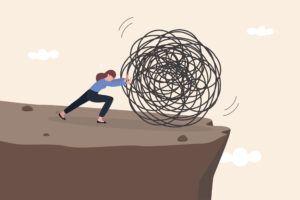There was a time when size 0 wasn’t a tag—it was a goal.
In the 1990s, thin wasn’t just in. It was everything. The cultural ideal of beauty was dictated by fashion runways, glossy magazine covers, and the meteoric rise of the supermodel—a phenomenon that redefined what it meant to be desirable, successful, and seen. For an entire generation, the message was clear: to be beautiful, you had to be skinny. Really skinny. The higher the cheekbones, the closer to God.
My Lifelong Battle with Food and Body Image
I was always the “chubby” kid. Not chubby enough to be considered “fat” – especially by modern day standards – but enough to feel awkward, be vulnerable and get bullied for it. I can remember when I hit puberty in eighth grade, the mean kids in school called me “Thunderthighs,”
That all changed in 9th grade, by a fortuitous event – my tonsils being taken out. My surgery was really rough and it was a whole month before I could eat anything other than popsicles and plain vanilla ice cream. Who knew that was such a great diet? I lost 25 pounds and all of a sudden, sure enough, I was the popular girl. I started turning heads when I walked into a room. I got asked to be in the “exclusive” clip. Even my own mother enabled my behavior by showering me with expensive designer clothes. The first time I zipped up a pair of extra small jeans, I almost cried with delight. I was addicted to being thin.
And I wasn’t alone either. The locker room was more for navel-gazing than changing, We would compare and judge who had the most prominent hip bones, ribs, and clavicles. Lunch became a diet coke and pretzels. And at the time the FDA hadn’t gone around to regulating diet pills that were essentially the same as speed.
Like most addictions, this one started to turn on me. I was constantly freezing to the point that I would just grab people’s hands for warmth. My hair became extremely brittle. Fortunately, I never lost a lot of it but I was headed in that direction. My parents started getting worried, then my teachers. But I couldn’t stop. And then it got worse when I got SO hungry I would binge on candy bars, then spend hours exercising.
Eventually, I had a healthier outlook on food and exercise. I would call it more of a distraction. College, partying, forming relationships. In my sophomore year at UVA I felt particularly lost and isolated from my friend group. Once again I turn toward controlling the one thing that was completely under my control and that was my eating. I lost a lot of weight and this time, I lost friends that were annoyed with me for always choosing the gym over hanging out with them, or hiding food all over my room. Some of this was probably on me for choosing the wrong friends. I eventually did a geographic and studied abroad in Australia for two semesters. The distance plus forming new meaningful relationships once again put me in a healthier situation.
Still, no matter how far I traveled or how badly I wanted to be “normal,” I found myself perpetually worshiping the altar of thinness. My whole day could be depending on how thin my arms looked. You might ask why would I write a book and start a fitness blog if I dealt and still deal with these issues? I think its because on some level we all struggle with having a compassionate attitude towards our bodies and accepting ourselves for who we are. It’s something that the body positive movement states is its mission on paper, but even if you go on social media it’s obvious that even that community has its own identity crisis.
Remembering these experiences from my past and how they shaped my outlook on body image today made me think of the larger cultural zeitgeist that existed when I was coming of age; the 90s and early aughts standards of thinness.
The Supermodel Standard: When Waif Was the Way
The 90s were dominated by a powerful handful of women known by first name only: Kate, Christy, Naomi, Cindy, Linda. These women didn’t just model clothes—they modeled aspiration. But over time, the toned bodies of the late 80s gave way to a new standard: the waif.
Enter Kate Moss. With her sunken cheeks, hollow eyes, and famously tiny frame, Moss embodied what came to be known as “heroin chic.” Suddenly, the goal was to look like you hadn’t eaten in days—and for many of us, that goal became dangerously real.
The phrase “Nothing tastes as good as skinny feels” wasn’t just a quote—it was a cultural commandment Uttered but none other than the queen herself Kate Moss, the first model to make heroin chic look amazing.
Body Checking: The Daily Obsession
Before Instagram selfies and body progress photos, there was the bathroom mirror. Body checking—a compulsive habit of scrutinizing one’s body—was quietly pervasive. We lifted our shirts to see if our stomachs were flat enough, pinched the skin on our arms, turned sideways to check for bloating, and compared thigh gaps in locker rooms. The goal wasn’t health—it was visible bones, flatness, thinness at all costs.
Diet Pills, Snackwells, and the Hunger Games
The diet industry flourished during this era. Shelves were lined with appetite suppressants and fat burners: Dexatrim, Metabolife, SlimQuick, Hydroxycut—all promising quick fixes and dramatic results. Nutrition labels became sacred texts, and fat-free, sugar-free, and calorie-counting ruled.
We chewed sugarless gum to suppress hunger. Drank cans of Diet Coke to get through the day. Ate Snackwells and thought we were winning. But really, many of us were starving—in more ways than one.
I, for one, chewed so much gum my jaw started to pop. I was very self-conscious when I ate in public. In high school I took a diet pill that is illegal to put on the market, probably because of the way it mimicked speed. Eventually, the message that these drugs were dangerouos for our internal organs resonated – until we entered the 2020s and the word semaglutide became as common as salt.
The Hidden Epidemic: Eating Disorders in the 90s
Eating disorders were prevalent, but rarely discussed. Instead of therapy or intervention, there was glorification—thinness was praised no matter how it was achieved. Magazines and media praised stars for dramatic weight loss. Celebrities like Calista Flockhart, Lara Flynn Boyle, and even teenage pop stars were either idolized for their smallness or shamed the second they gained weight.
It created a warped reality: the thinner you were, the more control, success, and value you seemed to have.
A Shift in the Spotlight: Curves Come Calling
By the early 2000s, the tide began to turn. Jennifer Lopez burst onto the scene with her iconic curves, followed by Beyoncé, and later, the early Kardashian rise. For the first time in decades, a fuller figure—specifically, hips and booty—was celebrated. Curves were “in,” but still had to be served with a flat stomach and toned thighs.
It was a shift—but not necessarily liberation. We were still being told what was beautiful. And only a few fit the mold.
The Post-Ozempic Era: Back to (Skinny) Basics?
Fast forward to now: in the age of Ozempic, Mounjaro, and prescription weight loss drugs, we’re seeing the pendulum swing yet again. Dramatic transformations are once again idolized. Suddenly, the heroin chic aesthetic is quietly reemerging on red carpets and TikTok feeds. Collar bones are back. So are whispers of size zero.
For a generation that already lived through the devastation of chasing that impossible ideal, it feels eerily familiar—and deeply unsettling.
We are, once again, being sold the fantasy that thinner is better. But this time, it comes in a prescription.
Climbing Out: Rewriting the Narrative
The 90s body trap may have been set decades ago, but its grip is still felt today. Healing from that mindset is hard. It requires unlearning decades of messaging, quieting the voice that says your worth is tied to your waistline, and building a new standard rooted in self-acceptance, strength, and health.
We owe it to our younger selves—and the next generation—to break the cycle. To make sure that the next Kate Moss moment doesn’t cost another wave of women their self-worth.
If you or someone you love is struggling with disordered eating, body dysmorphia, or the long-term effects of diet culture, you’re not alone—and there is help.
Hotlines and Support Services
- National Eating Disorders Association (NEDA) Helpline
Call or text: (800) 931-2237
Website: www.nationaleatingdisorders.org
Offers support, resources, and treatment options. - Crisis Text Line
Text “NEDA” to 741741 to connect with a trained crisis counselor.
Available 24/7 for emotional support. - National Alliance for Eating Disorders
Website: www.allianceforeatingdisorders.com
Provides education, support groups, and treatment referrals. - Eating Recovery Center
Website: www.eatingrecoverycenter.com
Specialized inpatient and outpatient care for all types of eating disorders.
Books That Rebuild Body Image & Celebrate Self-Worth
- “Anti-Diet: Reclaim Your Time, Money, Well-Being, and Happiness Through Intuitive Eating” by Christy Harrison
- “The Body Is Not an Apology” by Sonya Renee Taylor
A powerful guide to radical self-love and reclaiming your body. - “Body Kindness” by Rebecca Scritchfield
A practical and compassionate approach to health that isn’t rooted in shame. - “More Than a Body” by Lexie and Lindsay Kite, PhDs
Explores how to break free from body obsession and redefine beauty. - “What We Don’t Talk About When We Talk About Fat” by Aubrey Gordon
A bold, eye-opening look at anti-fat bias and the truth about weight stigma. - “Hunger” by Roxane Gay
A raw and honest memoir about trauma, body image, and reclaiming space.






